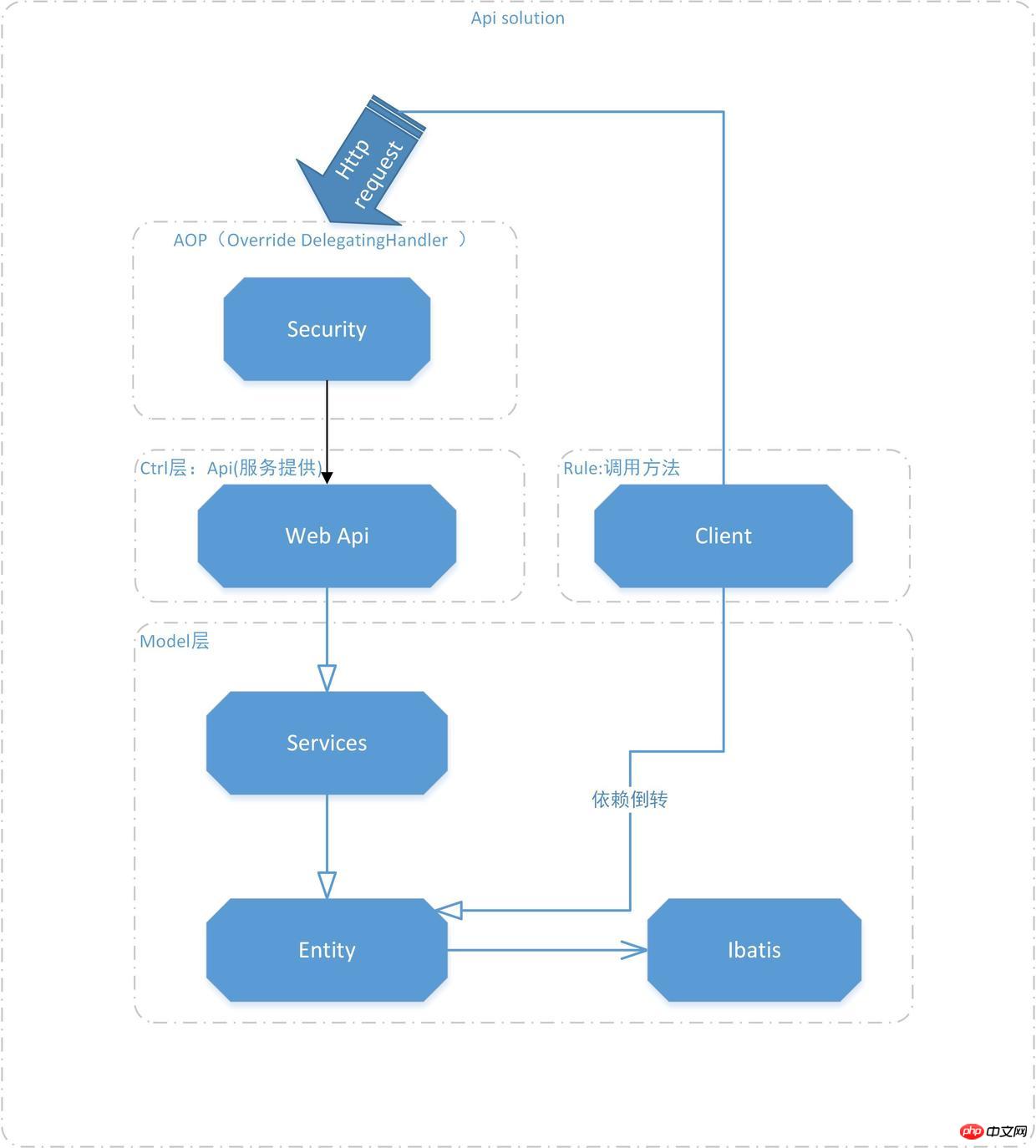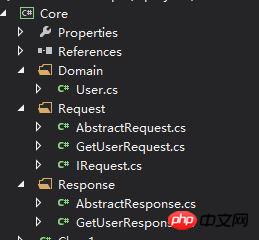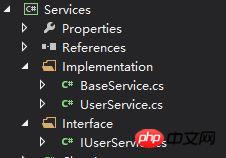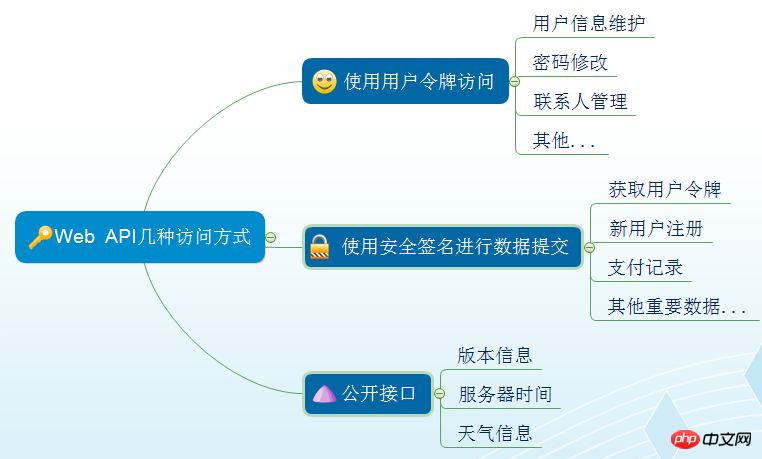 Backend Development
Backend Development
 C#.Net Tutorial
C#.Net Tutorial
 Asp.net (2) Business processing interface project (Web Api)
Asp.net (2) Business processing interface project (Web Api)
Asp.net (2) Business processing interface project (Web Api)
Introduction
ApiAs a business logic provider, it carries the core logic of the project and therefore has relatively high logic complexity. Under such a premise, how to simplify code writing, how to standardize and unify the writing style and logic specifications, and how to improve the maintainability and scalability of the code. It becomes important to build projects with high cohesion and low coupling.
The example is an enterprise-level project, FrameworkThe picture is as follows

dler) is rewritten, the validity of the request is judged, and the signature requirements are preprocessed. Client: defines a unified
interface calling method is used by the calling end, simplifying and unifying the use of the interface. Ctrl layer: As a direct provider of services, it directly provides an interface similar to RestFul style on the server (it feels strict RestFul style, requiring a complete domain
ModelDriver , the actual situation is always unsatisfactory, and the domain abstraction ability is not enough), obtain the request data, call FilterFilter on demand, make further judgments, and call
Model. Layer: As the business model layer, it provides the actual operation of business logic. Use a unified entity model and connect it to Ibatis for data operations. The specific code structure is as follows:

##Api-UML.jpg
The following is a detailed introduction and description of each module Code example:
Entity library project code example
The project structure is as follows:
 ##entity.jpg
##entity.jpg
main
module, as an entity model, the simple code is as followspublic class User
{
public int Id { get; set; }
public string NickName { get; set; }
public string Avatar { get; set; }
}public abstract class AbstractRequest
{
public bool ValidateParameters()
{
//公用方法示例,验证参数合法性
}
}
public interface IRequest<T> where T:AbstractResponse
{
//获取接口名称
string GetApiName();
//获取接口编码
string GetApiCode();
}
//获取User信息的请求结构定义
public class GetUserRequest:AbstractRequest,IRequest<GetUserResponse>
{
public int Id { get; set; }
public string GetApiName()
{
return "User.GetUserDetail";
}
public string GetApiCode()
{
return "User001";
}
}public abstract class AbstractResponse
{
//返回码
public int Code { get; set; }
//报错信息
public string Message { get; set; }
}
public class GetUserResponse:AbstractResponse
{
public User User { get; set; }
} service.jpg
service.jpg
public interface IUserService
{
GetUserResponse GetUser(int id);
}
public class BaseService
{
//protected SqlInstance sqlInstance;
public BaseService()
{
//sqlInstance=new SqlInstance(); //实例化数据库连接
//...
}
//...
}
public class UserService:BaseService,IUserService
{
public GetUserResponse GetUser(int id)
{
//链接数据库获取数据
//...
throw new NotImplementedException();
}
}Class library
Code exampleThe class library only handles security
issues and adds permission judgment at the api request entry . Use the method of rewriting Http requests.Code examplepublic class MyHandler : DelegatingHandler
{
protected async override Task<HttpResponseMessage> SendAsync(HttpRequestMessage request, CancellationToken cancellationToken)
{
IEnumerable<string> keyEnumerable;
var t1 = request.Headers.TryGetValues("key", out keyEnumerable);
var key = keyEnumerable.FirstOrDefault();
if (!true)//验证类似于token的权限
{
return await Task.Factory.StartNew<HttpResponseMessage>(
() => new HttpResponseMessage(HttpStatusCode.Forbidden)
{
Content = new StringContent("error message")
});
}
//如果有signature,判断,并加结果标志,没有的话,清除signature相关信息,防止伪造。
//.....
return await base.SendAsync(request, cancellationToken);
}
}
routing
security management
and interface permission control. To learn the permission control of WeChat, several interfaces have been roughly determined: Interface permissions.png
Interface permissions.png
The judgments of these permissions are all placed Centralized management is done in Security. The interface definition only needs to be used to judge the legality of the corresponding logic.
Code example:public class UserController : ApiController
{
private IUserService userService;
public UserController()
{
userService=new UserService();
}
[Signature]//安全签名过滤器判断
[HttpPost]
public GetUserResponse GetUser(GetUserRequest request)
{
//参数判断,安全性判断等等
var ret = userService.GetUser(request.Id);
return ret;
}
}The above is an example interface for obtaining user information. As for the routing configuration as the interface entrance, you need to judge the legality of the request. The routing configuration code is as follows:
public static void Register(HttpConfiguration config)
{
// Web API configuration and services
// Configure Web API to use only bearer token authentication.
config.SuppressDefaultHostAuthentication();
config.Filters.Add(new HostAuthenticationFilter(OAuthDefaults.AuthenticationType));
// Web API routes
config.MapHttpAttributeRoutes();
config.Routes.MapHttpRoute(
name: "DefaultApi",
routeTemplate: "api/{controller}/{action}",
defaults: new { id = RouteParameter.Optional }
);
//添加的代码,添加http请求的入口处理
config.MessageHandlers.Add(new MyHandler());
}1. Use generic interfaces to encapsulate the request class and return class to simplify the writing of calling code.
2. And make consumers call the interface through the proxy class, avoiding cross-domain problems.3. Consumer calls all agree to use a unified class library, so that the log processing is unified, and the returned errors can also be defined consistently.
Code examples are as follows:
public interface IClient
{
T Execute<T>(IRequest<T> request) where T : AbstractResponse;
}
public class DefaultClient:IClient
{
private readonly string appKey;
private readonly string appSecret;
private readonly string baseUrl = "http://localhost:16469/api/";
private readonly bool isNeedLogFile = false;
private readonly LogFile logFile;
public static readonly string SecureHeaderAppKey = "secure_head_appkey";
public static readonly string SecureHeaderSignature = "secure_head_signature";
public DefaultClient()
{
baseUrl = ConfigurationManager.AppSettings["service_base_url"];
appKey = ConfigurationManager.AppSettings["app_key"];
appSecret = ConfigurationManager.AppSettings["app_secret"];
isNeedLogFile = "1".Equals(ConfigurationManager.AppSettings["client_log_file"]);
logFile = new LogFile("client_log_path");
logFile.SubPath = appKey;
}
public DefaultClient(string serviceBase, string code, string key)
{
baseUrl = serviceBase;
appKey = code;
appSecret = key;
}
public T Execute<T>(IRequest<T> request) where T : AbstractResponse
{
var webRequest = (HttpWebRequest)WebRequest.Create(baseUrl + request.GetApiName());
webRequest.Method = "POST";
string reqJson;
string sign;
using (Stream rs = webRequest.GetRequestStream())
{
reqJson = JsonConvert.SerializeObject(request);
byte[] reqBytes = Encoding.UTF8.GetBytes(reqJson);
rs.Write(reqBytes, 0, reqBytes.Length);
rs.Close();
}
webRequest.ContentType = "application/json";
webRequest.Headers.Add(SecureHeaderAppKey, appKey);
sign = ComputeHash(appKey, appSecret, reqJson);
webRequest.Headers.Add(SecureHeaderSignature, sign);
//记录日志
if (isNeedLogFile)
{
logFile.Log(string.Format("[{0}] 请求内容: {1}", request.GetApiCode(), reqJson));
logFile.Log(string.Format("[{0}] 请求签名: {1}", request.GetApiCode(), sign));
}
try
{
using (var resp = (HttpWebResponse)webRequest.GetResponse())
{
try
{
Stream respStream = resp.GetResponseStream();
if (respStream == null)
{
throw new WebException("GetResponseStream returned null");
}
var streamReader = new StreamReader(respStream);
string respStr = streamReader.ReadToEnd();
//记录日志
if (isNeedLogFile)
{
logFile.Log(string.Format("[{0}] 响应内容: {1}", request.GetApiCode(), respStr));
}
return JsonConvert.DeserializeObject<T>(respStr);
}
catch (Exception e)
{
//记录日志
if (isNeedLogFile)
{
logFile.Log(string.Format("[{0}] 响应错误: {1}", request.GetApiCode(), e.Message));
}
throw new ApplicationException(e.Message, e);
}
}
}
catch (WebException e)
{
var errMsg = new StreamReader(e.Response.GetResponseStream()).ReadToEnd();
//记录日志
if (isNeedLogFile)
{
logFile.Log(string.Format("[{0}] 请求错误: {1}", request.GetApiCode(), errMsg));
}
throw new APIServiceException(errMsg);
}
}
private string ComputeHash(string key, string secret, string body)
{
return
Convert.ToBase64String(
SHA1.Create().ComputeHash(Encoding.Default.GetBytes(string.Concat(key, secret, body.Trim()))));
}
}以上就是Api项目端的各个核心环节的详细介绍。
接下来会对调用端即前端进行简单的介绍。Asp.net(三)Web端展示
The above is the detailed content of Asp.net (2) Business processing interface project (Web Api). For more information, please follow other related articles on the PHP Chinese website!

Hot AI Tools

Undresser.AI Undress
AI-powered app for creating realistic nude photos

AI Clothes Remover
Online AI tool for removing clothes from photos.

Undress AI Tool
Undress images for free

Clothoff.io
AI clothes remover

Video Face Swap
Swap faces in any video effortlessly with our completely free AI face swap tool!

Hot Article

Hot Tools

Notepad++7.3.1
Easy-to-use and free code editor

SublimeText3 Chinese version
Chinese version, very easy to use

Zend Studio 13.0.1
Powerful PHP integrated development environment

Dreamweaver CS6
Visual web development tools

SublimeText3 Mac version
God-level code editing software (SublimeText3)

Hot Topics
 1386
1386
 52
52
 What are the internal interfaces of a computer motherboard? Recommended introduction to the internal interfaces of a computer motherboard
Mar 12, 2024 pm 04:34 PM
What are the internal interfaces of a computer motherboard? Recommended introduction to the internal interfaces of a computer motherboard
Mar 12, 2024 pm 04:34 PM
When we assemble the computer, although the installation process is simple, we often encounter problems in the wiring. Often, users mistakenly plug the power supply line of the CPU radiator into the SYS_FAN. Although the fan can rotate, it may not work when the computer is turned on. There will be an F1 error "CPUFanError", which also causes the CPU cooler to be unable to adjust the speed intelligently. Let's share the common knowledge about the CPU_FAN, SYS_FAN, CHA_FAN, and CPU_OPT interfaces on the computer motherboard. Popular science on the CPU_FAN, SYS_FAN, CHA_FAN, and CPU_OPT interfaces on the computer motherboard 1. CPU_FANCPU_FAN is a dedicated interface for the CPU radiator and works at 12V
 Common programming paradigms and design patterns in Go language
Mar 04, 2024 pm 06:06 PM
Common programming paradigms and design patterns in Go language
Mar 04, 2024 pm 06:06 PM
As a modern and efficient programming language, Go language has rich programming paradigms and design patterns that can help developers write high-quality, maintainable code. This article will introduce common programming paradigms and design patterns in the Go language and provide specific code examples. 1. Object-oriented programming In the Go language, you can use structures and methods to implement object-oriented programming. By defining a structure and binding methods to the structure, the object-oriented features of data encapsulation and behavior binding can be achieved. packagemaini
 Introduction to PHP interfaces and how to define them
Mar 23, 2024 am 09:00 AM
Introduction to PHP interfaces and how to define them
Mar 23, 2024 am 09:00 AM
Introduction to PHP interface and how it is defined. PHP is an open source scripting language widely used in Web development. It is flexible, simple, and powerful. In PHP, an interface is a tool that defines common methods between multiple classes, achieving polymorphism and making code more flexible and reusable. This article will introduce the concept of PHP interfaces and how to define them, and provide specific code examples to demonstrate their usage. 1. PHP interface concept Interface plays an important role in object-oriented programming, defining the class application
 Solution to NotImplementedError()
Mar 01, 2024 pm 03:10 PM
Solution to NotImplementedError()
Mar 01, 2024 pm 03:10 PM
The reason for the error is in python. The reason why NotImplementedError() is thrown in Tornado may be because an abstract method or interface is not implemented. These methods or interfaces are declared in the parent class but not implemented in the child class. Subclasses need to implement these methods or interfaces to work properly. How to solve this problem is to implement the abstract method or interface declared by the parent class in the child class. If you are using a class to inherit from another class and you see this error, you should implement all the abstract methods declared in the parent class in the child class. If you are using an interface and you see this error, you should implement all methods declared in the interface in the class that implements the interface. If you are not sure which
 Application of interfaces and abstract classes in design patterns in Java
May 01, 2024 pm 06:33 PM
Application of interfaces and abstract classes in design patterns in Java
May 01, 2024 pm 06:33 PM
Interfaces and abstract classes are used in design patterns for decoupling and extensibility. Interfaces define method signatures, abstract classes provide partial implementation, and subclasses must implement unimplemented methods. In the strategy pattern, the interface is used to define the algorithm, and the abstract class or concrete class provides the implementation, allowing dynamic switching of algorithms. In the observer pattern, interfaces are used to define observer behavior, and abstract or concrete classes are used to subscribe and publish notifications. In the adapter pattern, interfaces are used to adapt existing classes. Abstract classes or concrete classes can implement compatible interfaces, allowing interaction with original code.
 Insight into Hongmeng system: actual function measurement and usage experience
Mar 23, 2024 am 10:45 AM
Insight into Hongmeng system: actual function measurement and usage experience
Mar 23, 2024 am 10:45 AM
As a new operating system launched by Huawei, Hongmeng system has caused quite a stir in the industry. As a new attempt by Huawei after the US ban, Hongmeng system has high hopes and expectations. Recently, I was fortunate enough to get a Huawei mobile phone equipped with Hongmeng system. After a period of use and actual testing, I will share some functional testing and usage experience of Hongmeng system. First, let’s take a look at the interface and functions of Hongmeng system. The Hongmeng system adopts Huawei's own design style as a whole, which is simple, clear and smooth in operation. On the desktop, various
 Inner class implementation of interfaces and abstract classes in Java
Apr 30, 2024 pm 02:03 PM
Inner class implementation of interfaces and abstract classes in Java
Apr 30, 2024 pm 02:03 PM
Java allows inner classes to be defined within interfaces and abstract classes, providing flexibility for code reuse and modularization. Inner classes in interfaces can implement specific functions, while inner classes in abstract classes can define general functions, and subclasses provide concrete implementations.
 Java interfaces and abstract classes: revealing the inner connection between them
Mar 04, 2024 am 09:34 AM
Java interfaces and abstract classes: revealing the inner connection between them
Mar 04, 2024 am 09:34 AM
Interface Interface defines abstract methods and constants in Java. The methods in the interface are not implemented, but are provided by the class that implements the interface. The interface defines a contract that requires the implementation class to provide specified method implementations. Declare the interface: publicinterfaceExampleInterface{voiddoSomething();intgetSomething();} Abstract class An abstract class is a class that cannot be instantiated. It contains a mixture of abstract and non-abstract methods. Similar to interfaces, abstract methods in abstract classes are implemented by subclasses. However, abstract classes can also contain concrete methods, which provide default implementations. Declare abstract class: publicabstractcl



